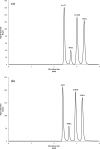Arsenic speciation using HPLC-ICP-MS in white and brown rice and health risk assessment
- PMID: 40853497
- PMCID: PMC12378713
- DOI: 10.1007/s10653-025-02723-2
Arsenic speciation using HPLC-ICP-MS in white and brown rice and health risk assessment
Abstract
Arsenic (As) contamination in rice poses significant health risks due to the toxicity of certain arsenicals. This study presents an improved, time-efficient method for quantifying arsenite (AsIII), arsenate (AsV), dimethylarsinic acid (DMA), and monomethylarsonic acid (MMA) in commercial white and brown rice using high-performance liquid chromatography coupled with inductively coupled plasma mass-spectrometry (HPLC-ICP-MS). The method incorporates chromatographic modifiers and ion-pairing agents in the mobile phase, reducing overall retention time to less than 4 minutes while enhancing peak separation. Method optimization, focusing on the solid-to-liquid ratio (g/L) and extraction time (minutes), was validated using the certified reference material (SRM 1568b Rice Flour), with measured concentrations showing good agreement with certified values. The MMA was excluded from the final analysis due to its low concentration in rice samples and minimal risk contribution. Arsenic species in rice followed the trend AsIII > DMA > AsV. No significant association was found between As levels and country of origin, but certain brown (MR 27, MR 29) and white (MR 10, MR 14) rice samples exceeded the European Commission's limit for inorganic As. Health risk assessments showed all rice samples had a target hazard quotient above 1, indicating potential non-carcinogenic risks. Additionally, estimated cancer risks exceeded the 10-3 (1 in 1000 lifetime risk) threshold under the revised cancer slope factor (CSF) value. This optimized method offers a reliable approach for detecting and quantifying As species in rice, aiding food safety monitoring and regulatory efforts.
Keywords: HPLC; ICP-MS; Inorganic arsenic; Rice; Risk assessment; Speciation analysis.
© 2025. The Author(s).
Conflict of interest statement
Declarations. Competing interests: The authors declare no competing interests.
Figures







References
-
- Ahmed, M. F., Mokhtar, M. B., & Alam, L. (2020). Carcinogenic and non-carcinogenic health risk of arsenic ingestion via drinking water in Langat River basin, Malaysia. Environmental Geochemistry and Health,43(2), 897–914. 10.1007/s10653-020-00571-w - PubMed
-
- Bao, J. (2023). Rice. ICC Handbook of 21st Century Cereal Science and Technology, pp. 145–151. 10.1016/b978-0-323-95295-8.00035-6
-
- Bundschuh, J., Niazi, N. K., Alam, M. A., Berg, M., Herath, I., Tomaszewska, B., Maity, J. P., & Ok, Y. S. (2022). Global arsenic dilemma and sustainability. Journal of Hazardous Materials. 10.1016/j.jhazmat.2022.129197 - PubMed
-
- Carey, M., Meharg, C., Williams, P., Marwa, E., Jiujin, X., Farias, J. G., De Silva, P. M., Signes-Pastor, A., Lu, Y., Nicoloso, F. T., Savage, L., Campbell, K., Elliott, C., Adomako, E., Green, A. J., Moreno-Jiménez, E., Carbonell-Barrachina, Á. A., Triwardhani, E. A., Pandiangan, F. I., … Meharg, A. A. (2019). Global sourcing of low-inorganic arsenic Rice Grain. Exposure and Health, 12(4), 711–719. 10.1007/s12403-019-00330-y
MeSH terms
Substances
Grants and funding
LinkOut - more resources
Full Text Sources
Medical
Research Materials

